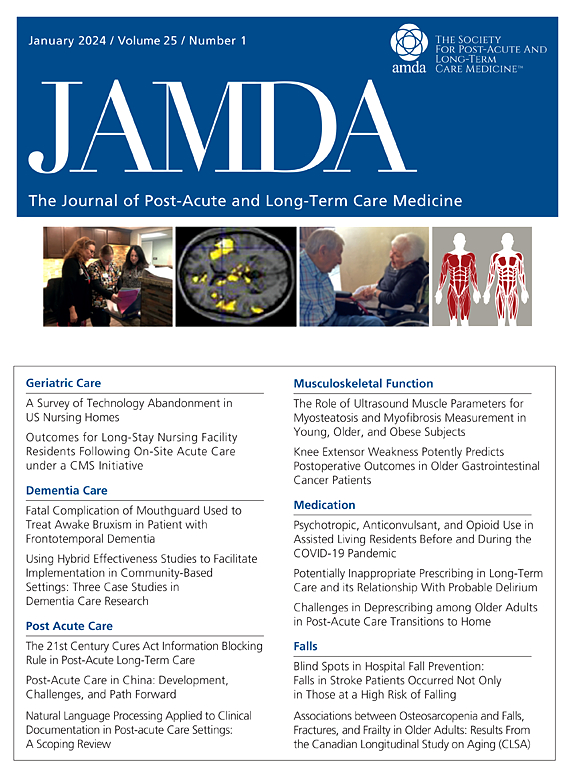3米后退行走试验对老年人跌倒风险的预测准确性
IF 4.2
2区 医学
Q2 GERIATRICS & GERONTOLOGY
Journal of the American Medical Directors Association
Pub Date : 2025-07-26
DOI:10.1016/j.jamda.2025.105580
引用次数: 0
摘要
目的:跌倒是老年人受伤的主要原因,准确预测跌倒风险的工具是必不可少的。本研究评估了3米后退步行测试(3 MBWT)对跌倒风险的预测准确性,并将其与短物理性能测试(SPPB)、10米步行测试(10 MWT)和跌倒相关问卷进行了比较。设计:横断面研究。环境和参与者:研究在奥地利维也纳的两家养老院进行。共纳入217名参与者(女性65.9%,中位年龄80岁)。方法:采用访谈和Cogvis 3D传感器系统,回顾性记录12个月以上的跌倒史,前瞻性记录4个月以上的跌倒史。通过受试者工作特征曲线和曲线下面积(AUC)分析来评估预测准确性,而泊松回归用于分析跌倒发生率。结果:在参与者中,86人(39.6%)报告在过去12个月内跌倒。对于回顾性跌倒,SPPB (AUC, 0.76)、3 MBWT (AUC, 0.75)和10 MWT (AUC, 0.73)显示出相似的预测准确性。对于预期的跌倒,SPPB (AUC, 0.75)和3 MBWT (AUC, 0.74)保持相似的准确性,而10 MWT的预测能力较低(AUC, 0.67)。对于3 MBWT,回顾性跌倒的截止点≥9.31秒(发生率高32%;95% CI, 1.05-1.95),预期跌倒≥8.15秒(发生率高27%;95% ci, 1.02-1.66)。3 MBWT表现每增加1秒,摔倒发生率增加(回顾性,7%;未来,5%)。结论和意义:3 MBWT与SPPB具有相当的准确性,在预测跌倒方面的表现略好于10 MWT。它的效率、预测价值和节省时间使其成为老年人临床跌倒风险评估的实用可行的工具。本文章由计算机程序翻译,如有差异,请以英文原文为准。
Predictive Accuracy of the 3-m Backward Walk Test for Fall Risk in Older Adults
Objectives
Falls are a leading cause of injury in older adults, and accurate tools to predict fall risk are essential. This study evaluates the predictive accuracy of the 3-m Backward Walk Test (3 MBWT) for fall risk, comparing it with the Short Physical Performance Battery (SPPB), 10-m walk test (10 MWT), and fall-related questionnaires.
Design
Cross-sectional study.
Setting and Participants
The study was conducted in 2 nursing homes in Vienna, Austria. A total of 217 participants (65.9% female, median age, 80 years) were included.
Methods
Fall history was recorded retrospectively over 12 months and prospectively over 4 months using interviews and a Cogvis 3D sensor system. Predictive accuracy was assessed with receiver operating characteristic curves and area under the curve (AUC) analyses, whereas Poisson regression was used to analyze fall incidence.
Results
Among participants, 86 (39.6%) reported a fall within the previous 12 months. For retrospective falls, the SPPB (AUC, 0.76), 3 MBWT (AUC, 0.75), and 10 MWT (AUC, 0.73) showed similar predictive accuracy. For prospective falls, the SPPB (AUC, 0.75) and 3 MBWT (AUC, 0.74) remained similarly accurate, whereas the 10 MWT had lower predictive power (AUC, 0.67). For the 3 MBWT, cutoff points were ≥9.31 seconds for retrospective falls (32% higher incidence; 95% CI, 1.05–1.95) and ≥8.15 seconds for prospective falls (27% higher incidence; 95% CI, 1.02–1.66). Each additional second in 3 MBWT performance increased fall incidence (retrospective, 7%; prospective, 5%). SPPB cutoffs of <7.02 and <8.00 were associated with 49% (95% CI, 1.06–2.21) and 30% (95% CI, 1.02–1.74) higher fall incidence, respectively.
Conclusions and Implications
The 3 MBWT shows comparable accuracy with the SPPB and moderately better performance than the 10 MWT for prospective falls. Its efficiency, predictive value, and time savings make it a practical and viable tool for clinical fall risk assessment in older adults.
求助全文
通过发布文献求助,成功后即可免费获取论文全文。
去求助
来源期刊
CiteScore
11.10
自引率
6.60%
发文量
472
审稿时长
44 days
期刊介绍:
JAMDA, the official journal of AMDA - The Society for Post-Acute and Long-Term Care Medicine, is a leading peer-reviewed publication that offers practical information and research geared towards healthcare professionals in the post-acute and long-term care fields. It is also a valuable resource for policy-makers, organizational leaders, educators, and advocates.
The journal provides essential information for various healthcare professionals such as medical directors, attending physicians, nurses, consultant pharmacists, geriatric psychiatrists, nurse practitioners, physician assistants, physical and occupational therapists, social workers, and others involved in providing, overseeing, and promoting quality

 求助内容:
求助内容: 应助结果提醒方式:
应助结果提醒方式:


